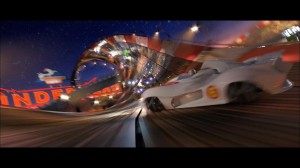 seen far too many properties from the baby-boom picked up and turned into utter dreck by producers, writers, and directors who had absolutely no respect for the original source material. So Speed Racer waited until I got around to it on Netflix, because that is one thing the service is great for, taking risky experimental leaps in your cinema viewing.
seen far too many properties from the baby-boom picked up and turned into utter dreck by producers, writers, and directors who had absolutely no respect for the original source material. So Speed Racer waited until I got around to it on Netflix, because that is one thing the service is great for, taking risky experimental leaps in your cinema viewing.
The Wachowskis; the sibling duo responsible for The Matrix franchise and the film adaptation of V for Vendetta, directed the film. Speed Racer displays all the visual style and experimentation one should expect from the Wachowskis. The story is simple, Speed and his family are a small independent racing team and motor car company. (Pops, play by John Goodman, builds the race cars in his home garage.) Speed’s older brother has been disgraced and killed in an earlier off road race. Speeds own inherent talent has brought him to the attention of a major motor-company mogul Royalton, played with villainous flair that seemed to strike a resonate cord reminiscent of the acerbic Christopher Hitchens by Roger Allam. Royalton tries to seduce Speed into signing on a corporate racer, and when rebuffed turns his energies to destroyed Speed and the Racer family.
If you have watched the 60’s animated show you know that the program constantly dealt in absurd impossibilities, cars that leap great distanced thanks to powered jacks, fantastic weaponry, amazing capable pet chimps, and so on. Adapting this sort of material into a film usually calls for eliminating as much as possible these cue that are acceptable in animation, but shattering to suspension of disbelief in photography; this was not the approach the Wochowskis employed. Rather they embraced the animated style, integrating into it the live-action performers, mixing CGI that had been rendered to reflect the style of animation and not photo-realism, while layering in the actors as real people. (Even Chim-Chim the chimp is real not a CGI character.) The final product is both mad-cap over the top, and layered with character moments and performances.
The film disappointed at the box officer and I think the stylistic approach is the final culprit. The animation elements, I believe in form the viewer the accept one level of reality and the live-action performances ask the viewer to accept quite a different level of reality. The dichotomy of these two very different expectations creates a jarring effect that is quite deleterious to suspension of disbelief.
That said, if you can find a way to let your mind work on the two levels simultaneously, the film has surprisingly entertaining moments. It was clearly crafted with an eye towards the source material. From my memory the Wochowskis nailed every major plot and character element of the show, while adding a level of story that the television program never explored. It was a bold, brash experiment that failed, but I salute them as artists for their vision and the risk taking. They could have made a bland cookie-cutter film, but instead that took real risks and that should be rewarded.
